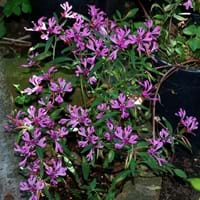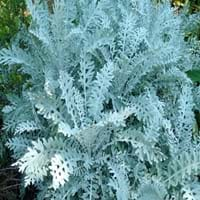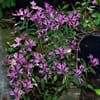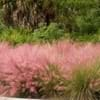Life Span
Annual
Annual and Perennial
Type
Flowering Plants
Tender Perennial
Origin
United States, California
Southern Europe, Mediterranean
Types
Santa Clara red ribbons, red ribbons, Raiche's red ribbons
Silver Lace, Cirrus
Habitat
Dry areas, foothill woods
Coastal Regions, Warmer regions
USDA Hardiness Zone
Not Available
7-11
Sunset Zone
A3, 1a, 1b, 2a, 2b, 3a, 3b, 4, 5, 6, 7, 8, 9, 10, 11, 12, 13, 14, 15, 16, 17, 18, 19, 20, 21, 22, 23, 24
H1, H2, 8, 9, 10, 11, 12, 13, 14, 15, 16, 17, 18, 19, 20, 21, 22, 23, 24
Habit
Clump-Forming
Cushion/Mound-forming
Flower Color
Pink, Fuchsia, Rose, Lavender
White, Yellow, Purple
Flower Color Modifier
Bicolor
Bicolor
Fruit Color
Not Available
Tan
Leaf Color in Spring
Green, Gray Green
Blue Green, Silver
Leaf Color in Summer
Green, Gray Green
Blue Green, Silver
Leaf Color in Fall
Green, Gray Green
Blue Green, Silver
Leaf Color in Winter
Light Green
Light Green
Leaf Shape
Ovate
Irregular
Plant Season
Spring, Summer
Spring, Summer, Fall, Winter
Sunlight
Partial Sun, Partial shade
Full Sun
Type of Soil
Loam, Sand
Clay, Loam, Sand
The pH of Soil
Neutral
Acidic, Neutral, Alkaline
Soil Drainage
Well drained
Well drained
Bloom Time
Spring, Late Spring, Early Summer, Summer
Early Summer, Summer, Late Summer
Tolerances
Not Available
Drought
Where to Plant?
Container, Ground, Pot
Container, Ground
How to Plant?
Seedlings, Stem Planting
Seedlings, Stem Planting
Plant Maintenance
Medium
Medium
Watering Requirements
Allow to dry out slightly between watering
Do Not over Water, Never Over-water, Requires regular watering, Requires watering in the growing season, Water Deeply
In Summer
Lots of watering
Lots of watering
In Spring
Moderate
Moderate
In Winter
Average Water
Average Water
Soil pH
Neutral
Acidic, Neutral, Alkaline
Soil Type
Loam, Sand
Clay, Loam, Sand
Soil Drainage Capacity
Well drained
Well drained
Sun Exposure
Part sun, Partial shade
Full Sun
Pruning
Remove damaged leaves, Remove dead branches, Remove dead leaves
Remove dead leaves, Remove deadheads
Fertilizers
All-Purpose Liquid Fertilizer
fertilize every 2-3 weeks while growing, Nitrogen, Phosphorous, Potassium
Pests and Diseases
Red blotch
Blight, Downy mildew, Powdery mildew, Red blotch, Rust, White mold
Plant Tolerance
Drought
Drought
Flowers
Showy
Insignificant
Flower Petal Number
Single
Single
Showy Foliage
Not Available
Yes
Foliage Texture
Fine
Medium
Foliage Sheen
Matte
Matte
Attracts
Butterflies
Flying insects, Insects
Allergy
Not Available
Avoid during Pregnancy, Skin irritation, Skin rash, Toxic
Aesthetic Uses
Showy Purposes
Showy Purposes
Beauty Benefits
Not Available
No Beauty Benefits
Environmental Uses
Air purification
Air purification, Food for insects, Prevent Soil Erosion
Medicinal Uses
Not Available
Headache, Menstrual Disorders, Migraines
Part of Plant Used
Not Available
Leaves
Other Uses
Used as Ornamental plant, Used for its medicinal properties
Employed in herbal medicine, Showy Purposes, Used as Ornamental plant, Used for its medicinal properties
Used As Indoor Plant
No
Yes
Used As Outdoor Plant
Yes
Yes
Garden Design
Bedding Plant, Showy Tree
Bedding Plant, Container, Cutflower, Edging, Mixed Border, Rock Garden / Wall
Botanical Name
CLARKIA concinna
CENTAUREA cineraria
Common Name
Red Ribbons
Silver dust
In Hindi
Clarkia concinna
डस्टी मिलर
In German
Clarkia concinna
Dusty Miller
In French
Clarkia concinna
Dusty Miller
In Spanish
concinna clarkia
Dusty Miller
In Greek
Clarkia concinna
Dusty Miller
In Portuguese
Clarkia concinna
Dusty Miller
In Polish
klarkia concinna
Dusty Miller
In Latin
Clarkia concinna
Dusty Cicero
Phylum
Tracheophyta
Anthophyta
Class
Magnoliopsida
Magnoliopsida
Family
Onagraceae
Asteraceae
Clade
Angiosperms, Eudicots, Rosids
Angiosperms, Asterids, Eudicots
Tribe
Not Available
Cynareae
Subfamily
Not Available
Carduoideae
Number of Species
Not Available
Not Available
Season and Care of Clarkia concinna and Dusty Miller
Season and care of Clarkia concinna and Dusty Miller is important to know. While considering everything about Clarkia concinna and Dusty Miller Care, growing season is an essential factor. Clarkia concinna season is Spring and Summer and Dusty Miller season is Spring and Summer. The type of soil for Clarkia concinna is Loam, Sand and for Dusty Miller is Clay, Loam, Sand while the PH of soil for Clarkia concinna is Neutral and for Dusty Miller is Acidic, Neutral, Alkaline.
Clarkia concinna and Dusty Miller Physical Information
Clarkia concinna and Dusty Miller physical information is very important for comparison. Clarkia concinna height is 25.40 cm and width 25.40 cm whereas Dusty Miller height is 20.30 cm and width 30.50 cm. The color specification of Clarkia concinna and Dusty Miller are as follows:
Clarkia concinna flower color: Pink, Fuchsia, Rose and Lavender
Clarkia concinna leaf color: Green and Gray Green
Dusty Miller flower color: White, Yellow and Purple
- Dusty Miller leaf color: Blue Green and Silver
Care of Clarkia concinna and Dusty Miller
Care of Clarkia concinna and Dusty Miller include pruning, fertilizers, watering etc. Clarkia concinna pruning is done Remove damaged leaves, Remove dead branches and Remove dead leaves and Dusty Miller pruning is done Remove dead leaves and Remove deadheads. In summer Clarkia concinna needs Lots of watering and in winter, it needs Average Water. Whereas, in summer Dusty Miller needs Lots of watering and in winter, it needs Average Water.





